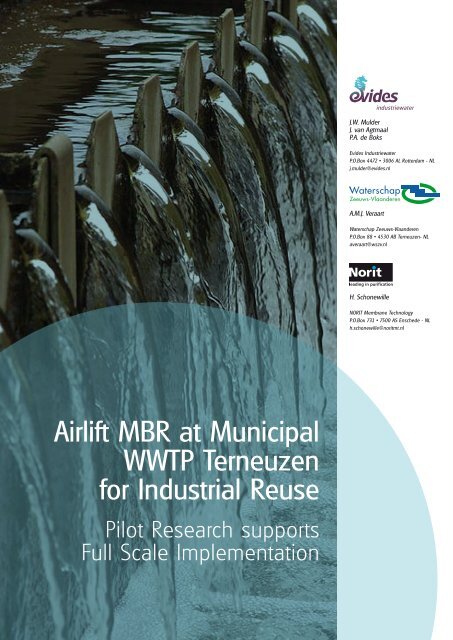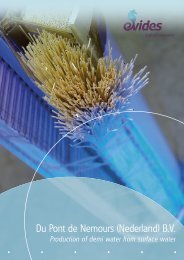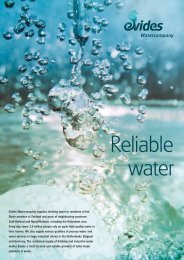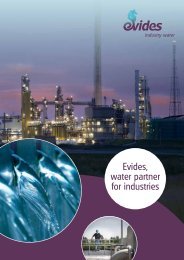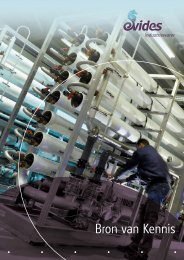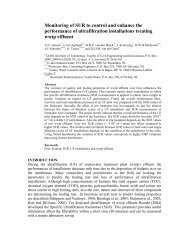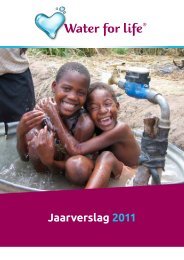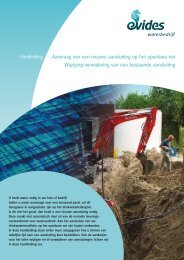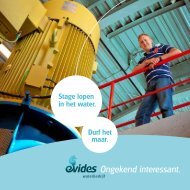Airlift MBR at Municipal WWTP Terneuzen for Industrial ... - Evides
Airlift MBR at Municipal WWTP Terneuzen for Industrial ... - Evides
Airlift MBR at Municipal WWTP Terneuzen for Industrial ... - Evides
You also want an ePaper? Increase the reach of your titles
YUMPU automatically turns print PDFs into web optimized ePapers that Google loves.
<strong>Airlift</strong> <strong>MBR</strong> <strong>at</strong> <strong>Municipal</strong><br />
<strong>WWTP</strong> <strong>Terneuzen</strong><br />
<strong>for</strong> <strong>Industrial</strong> Reuse<br />
Pilot Research supports<br />
Full Scale Implement<strong>at</strong>ion<br />
J.W. Mulder<br />
J. van Agtmaal<br />
P.A. de Boks<br />
<strong>Evides</strong> Industriew<strong>at</strong>er<br />
P.O.Box 4472 • 3006 AL Rotterdam - NL<br />
j.mulder@evides.nl<br />
A.M.J. Veraart<br />
W<strong>at</strong>erschap Zeeuws-Vlaanderen<br />
P.O.Box 88 • 4530 AB <strong>Terneuzen</strong>- NL<br />
averaart@wszv.nl<br />
H. Schonewille<br />
NORIT Membrane Technology<br />
P.O.Box 731 • 7500 AS Enschede - NL<br />
h.schonewille@noritmt.nl
Introduction Project Scope<br />
• The municipal wwtp <strong>Terneuzen</strong> is oper<strong>at</strong>ed by W<strong>at</strong>er Authority<br />
‘Zeeuws-Vlaanderen’ in the Netherlands.<br />
• Present capacity of the wwtp is 77,500 Pollution Equivalents.<br />
• The plant was built in 1990, several extensions took place over<br />
the years to meet stricter requirements <strong>for</strong> N- and P-removal.<br />
• Since 2007 a volume of 5,000 m 3 per day of effluent is tre<strong>at</strong>ed<br />
by <strong>Evides</strong> Industry W<strong>at</strong>er to produce demineralised w<strong>at</strong>er <strong>for</strong><br />
reuse <strong>at</strong> Dow Benelux.<br />
• It is the first example of a combin<strong>at</strong>ion of industrial and munici-<br />
pal wastew<strong>at</strong>er <strong>for</strong> reuse on a large scale in the Netherlands.<br />
The wwtp of <strong>Terneuzen</strong>,<br />
including the projected<br />
upgrading with an airlift <strong>MBR</strong><br />
Principle of the NORIT air lift <strong>MBR</strong><br />
Bioreactor<br />
and Objectives<br />
• Upgrading is needed in the near future <strong>for</strong> improvement of the<br />
effluent quality.<br />
• The volume of effluent reuse has to be doubled be<strong>for</strong>e in 2010.<br />
• The <strong>Terneuzen</strong> wwtp will be upgraded with an <strong>MBR</strong> system in<br />
the year 2009.<br />
• The <strong>MBR</strong> system will have a nominal hydraulic capacity of<br />
400 m 3 /hr and a maximum hydraulic capacity of 620 m 3 /h.<br />
• The perme<strong>at</strong>e from the <strong>MBR</strong> will not be discharged into the<br />
environment, but fed to an RO membrane unit <strong>for</strong> further<br />
polishing and reuse as boiler feed w<strong>at</strong>er.<br />
• To increase the hydraulic load to the <strong>MBR</strong>, clarifier overflow<br />
of the existing wwtp will be added to the <strong>MBR</strong>.<br />
• Currently a NORIT <strong>MBR</strong> <strong>Airlift</strong> pilot plant is oper<strong>at</strong>ed and<br />
gener<strong>at</strong>es process d<strong>at</strong>a to service the engineering <strong>for</strong> the<br />
full scale <strong>MBR</strong> plant.<br />
• Objectives <strong>for</strong> the pilot scale research are determining the<br />
feasibility of different effluent addition schemes and the<br />
maximum and oper<strong>at</strong>ional membrane flux.<br />
• In rel<strong>at</strong>ion to the production of demineralised w<strong>at</strong>er the<br />
requirements <strong>for</strong> the perme<strong>at</strong>e are 10 mg/l <strong>for</strong> N-total and<br />
2 mg/l <strong>for</strong> P-total.<br />
Membrane feed<br />
Air release<br />
Air lift<br />
Chemical cleaning<br />
Backwash<br />
Perme<strong>at</strong>e<br />
Pilot plant<br />
Influent 80%<br />
Effluent<br />
1,000-<br />
3,100 m 3 /h<br />
20%<br />
<strong>MBR</strong><br />
Future situ<strong>at</strong>ion after upgrading the wwtp with the <strong>MBR</strong><br />
Addition clarifier overflow<br />
M<strong>at</strong>erials<br />
and Methods<br />
• Both the full scale and the pilot plant are equipped with<br />
<strong>Airlift</strong> <strong>MBR</strong> by NORIT Membrane Technology (Enschede,<br />
The Netherlands).<br />
• The NORIT airlift has its first full scale applic<strong>at</strong>ion <strong>at</strong> the wwtp of<br />
the town of Ootmarsum, The Netherlands (Futselaar et al, 2007).<br />
• The pilot plant has a hydraulic capacity of 3 m 3 /h.<br />
• The maximum gross flux amounts to 50 l/m 2 *h.<br />
• Iron(III)chloride is added to the <strong>MBR</strong> <strong>for</strong> chemical P-removal<br />
• For determining the sludge quality the Delft Filtr<strong>at</strong>ion<br />
Characteriz<strong>at</strong>ion Method (DFCM) method has been used<br />
(Evenblij et al, 2005)<br />
<strong>Industrial</strong> reuse<br />
400-620 m 3 /h
Results Discussion<br />
• The sustainable continuous flux was 40 l/m 2 *h.<br />
• No significant influence of clarifier overflow addition has been<br />
noticed.<br />
• Sludge quality with the DFCM measurements was good in<br />
different r<strong>at</strong>ios of addition of clarifier overflow. The average<br />
filterability was 0.2. Values below 1.0 should be considered<br />
as good filterable.<br />
• The average concentr<strong>at</strong>ion <strong>for</strong> P-total was 1.7.<br />
No optimiz<strong>at</strong>ion of P-removal had been carried out yet.<br />
• Nitrific<strong>at</strong>ion was almost complete.<br />
• Denitrific<strong>at</strong>ion was variable due to several problems with the<br />
Flux (l/m2*h)<br />
process control.<br />
60<br />
50<br />
40<br />
30<br />
20<br />
10<br />
<strong>MBR</strong> influent Perme<strong>at</strong>e<br />
COD (mg/l) 458 33<br />
TKN (mg/l) 44 2.3<br />
NO3-N (mg/l) 7.8 (0.2–20)<br />
PO4-P (mg/l) 1.4<br />
P-total (mg/l) 6.4 1.7<br />
gross flux Permeability<br />
addition of<br />
sec. clarifier overflow<br />
0<br />
dec-08 jan-09 feb-09<br />
Average quality<br />
influent and perme<strong>at</strong>e<br />
and Conclusions<br />
The <strong>WWTP</strong> <strong>Terneuzen</strong> (The Netherlands) will be upgraded with an<br />
airlift <strong>MBR</strong> system in the year 2009. A pilot plant has been oper-<br />
<strong>at</strong>ed to gener<strong>at</strong>e process d<strong>at</strong>a. The airlift system in the pilot<br />
plant reached a high sustainable flux of 40 l/m 2 *h continuously.<br />
The inlet flow of the full scale <strong>MBR</strong> will be 200-620 m 3 /h.<br />
The required perme<strong>at</strong>e production of 400-620 m 3 /h will be reached<br />
by addition of clarifier overflow. This concept has not been applied<br />
earlier and influences on the per<strong>for</strong>mance were unknown.<br />
After introduction of this addition no neg<strong>at</strong>ive influences on the<br />
membrane per<strong>for</strong>mance appeared. This observ<strong>at</strong>ion was supported<br />
by the DFCM measurements by the Technical University of Delft.<br />
In the future the perme<strong>at</strong>e from the 620 m 3 /hr <strong>Airlift</strong> <strong>MBR</strong> will be<br />
exclusively used as feed w<strong>at</strong>er <strong>for</strong> the production of demineralised<br />
w<strong>at</strong>er <strong>for</strong> a local chemical industry. In the pilot plant the minimum<br />
requirements are almost met. However the process control in the<br />
bioreactor showed some instabilities. In the full scale plant a better<br />
perme<strong>at</strong>e quality is expected.<br />
Membrane per<strong>for</strong>mance Result sludge filterability measurements<br />
500<br />
450<br />
400<br />
350<br />
300<br />
250<br />
200<br />
150<br />
100<br />
50<br />
0<br />
permeability (l/m2*h*bar)<br />
filtr<strong>at</strong>ion resistance dR20 (X10 12 m -1 )<br />
1,0<br />
0,9<br />
0,8<br />
0,7<br />
0,6<br />
0,5<br />
0,4<br />
0,3<br />
0,2<br />
0,1<br />
0,0<br />
1st series 2nd series<br />
Values below 1.0 should be considered as good filterable<br />
0 38 56 75<br />
% of effluent addition<br />
References<br />
Agtmaal J, Huiting H, de Boks PA, Paping LLMJ (2007) Four years of practical experience with an Integr<strong>at</strong>ed Membrane System tre<strong>at</strong>ing estuary w<strong>at</strong>er, Desalin<strong>at</strong>ion 205, 26-37.<br />
Evenblij, H., Geilvoet, S., van der Graaf, J.H.J.M., van der Roest, H.F. (2005) Filtr<strong>at</strong>ion Characteris<strong>at</strong>ion <strong>for</strong> assessing <strong>MBR</strong> per<strong>for</strong>mance: three cases compared, Desalin<strong>at</strong>ion, 178, 115-124.<br />
Futselaar H, Schonewille H, de Vente D, Broens l (2007) NORIT <strong>Airlift</strong> <strong>MBR</strong>: side-stream system <strong>for</strong> municipal waste w<strong>at</strong>er tre<strong>at</strong>ment, Desalin<strong>at</strong>ion 204, 1-7.


